ASUS X99-A Motherboard Review
by Ian Cutress on December 22, 2014 2:00 PM EST- Posted in
- Motherboards
- Intel
- Asus
- Haswell-E
- LGA2011-3
System Performance
Power Consumption
Power consumption was tested on the system while in a single MSI GTX 770 Lightning GPU configuration with a wall meter connected to the OCZ 1250W power supply. This power supply is Gold rated, and as I am in the UK on a 230-240 V supply, leads to ~75% efficiency > 50W, and 90%+ efficiency at 250W, suitable for both idle and multi-GPU loading. This method of power reading allows us to compare the power management of the UEFI and the board to supply components with power under load, and includes typical PSU losses due to efficiency. These are the real world values that consumers may expect from a typical system (minus the monitor) using this motherboard.
While this method for power measurement may not be ideal, and you feel these numbers are not representative due to the high wattage power supply being used (we use the same PSU to remain consistent over a series of reviews, and the fact that some boards on our test bed get tested with three or four high powered GPUs), the important point to take away is the relationship between the numbers. These boards are all under the same conditions, and thus the differences between them should be easy to spot.



It would seem that the X99 motherboards are filtering into several bands of peak load power usage, around 200W, 210-220W and 240W+. The ASUS fits into the low end of that middle band.
Windows 7 POST Time
Different motherboards have different POST sequences before an operating system is initialized. A lot of this is dependent on the board itself, and POST boot time is determined by the controllers on board (and the sequence of how those extras are organized). As part of our testing, we look at the POST Boot Time using a stopwatch. This is the time from pressing the ON button on the computer to when Windows 7 starts loading. (We discount Windows loading as it is highly variable given Windows specific features.)
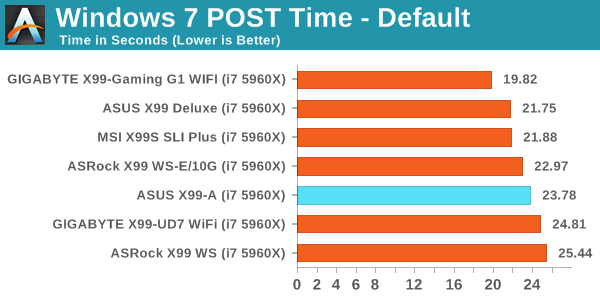
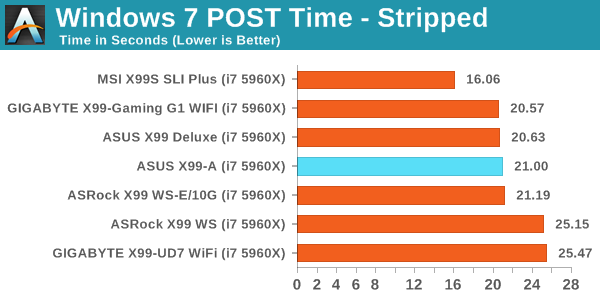
POST Times of all X99 motherboards are around the 20-25 second mark, and on the BIOS we used we saw almost 24 seconds.
Rightmark Audio Analyzer 6.2.5
Rightmark:AA indicates how well the sound system is built and isolated from electrical interference (either internally or externally). For this test we connect the Line Out to the Line In using a short six inch 3.5mm to 3.5mm high-quality jack, turn the OS speaker volume to 100%, and run the Rightmark default test suite at 192 kHz, 24-bit. The OS is tuned to 192 kHz/24-bit input and output, and the Line-In volume is adjusted until we have the best RMAA value in the mini-pretest. We look specifically at the Dynamic Range of the audio codec used on board, as well as the Total Harmonic Distortion + Noise.
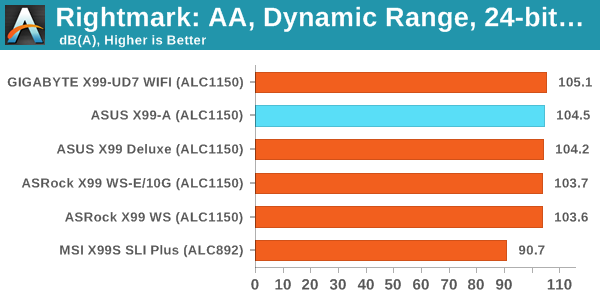

The X99-A performs extremely well in our audio testing, scoring some of the best results we have ever seen.
USB Backup
For this benchmark, we transfer a set size of files from the SSD to the USB drive using DiskBench, which monitors the time taken to transfer. The files transferred are a 1.52 GB set of 2867 files across 320 folders – 95% of these files are small typical website files, and the rest (90% of the size) are small 30 second HD videos. In an update to pre-Z87 testing, we also run MaxCPU to load up one of the threads during the test which improves general performance up to 15% by causing all the internal pathways to run at full speed.
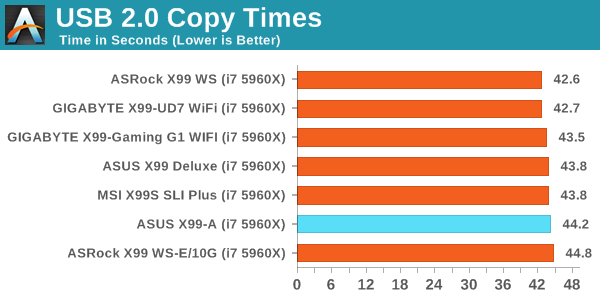
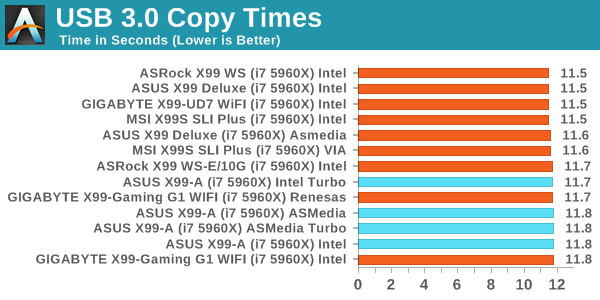
USB performance was on the low end compared to our other motherboards tested.
DPC Latency
Deferred Procedure Call latency is a way in which Windows handles interrupt servicing. In order to wait for a processor to acknowledge the request, the system will queue all interrupt requests by priority. Critical interrupts will be handled as soon as possible, whereas lesser priority requests such as audio will be further down the line. If the audio device requires data, it will have to wait until the request is processed before the buffer is filled.
If the device drivers of higher priority components in a system are poorly implemented, this can cause delays in request scheduling and process time. This can lead to an empty audio buffer and characteristic audible pauses, pops and clicks. The DPC latency checker measures how much time is taken processing DPCs from driver invocation. The lower the value will result in better audio transfer at smaller buffer sizes. Results are measured in microseconds.
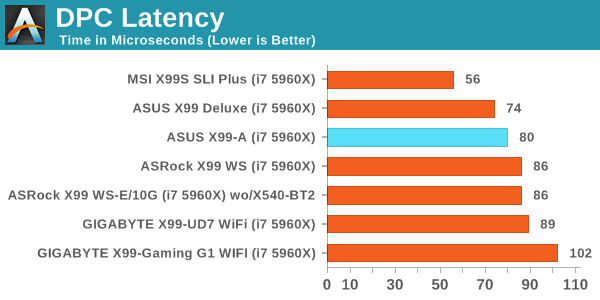
All X99 motherboards are aiming at the sub-100 microsecond category, and the X99-A fits in there with a score of 80.











37 Comments
View All Comments
DanNeely - Tuesday, December 23, 2014 - link
No. Look at the pictures; 6 blue (3.0) and 4 black (2.0) USB ports.Until Intel goes all USB3 on it chipset, most boards with many ports are either going to do a mix of both types, fake it with hub chips, or both. And since the Skylake Leaks indicate we'll probably still be mixed USB (or hub) on higher end boards (midrange will probably be able to go all 3.0); it's probably going to be 2017 until USB3.x becomes ubiquitous.
kenshinco - Tuesday, December 23, 2014 - link
You said this board doesn't implement Multicore Turbo but its specs does says Intel Turbo boost supported. Could you elaborate more on this.Does this means it will get turbo boosted for single core only? 8 cores active can not get turbo boosted?
SuperVeloce - Wednesday, December 24, 2014 - link
This most likely means turbo boost is behaving as Intel said it should, more cores active, lower the frequency (for 5960x and all cores its usually 3-3.2ghz). Multicore turbo usually gets you highest turbo frequency for all cores (so it would leave it 3.5ghz@16threads if temperatures allow it).dcoca - Friday, January 9, 2015 - link
I have this board and Multicore is there in the bios with the opt for all cores or per core...EricCC - Wednesday, December 24, 2014 - link
Great article. I was ready to buy one until I saw the post times. 20+ seconds is horrible. My two year old Surface and one year laptop with Haswell post in 2-3 seconds and their CPUs are much slower. And my 5+ year old system is twice as fast posting.I thought EFI BIOS were supposed to be significantly faster and I expected newer machines to be faster. Have manufacturers explained the severe slowness?
Are these new motherboards any faster with Windows 8?
EricCC - Wednesday, December 24, 2014 - link
i should have said, any faster POSTING with Windows 8?DanNeely - Wednesday, December 24, 2014 - link
POST is the time spend *before* the boot loader starts your OS. In general, the more stuff that needs to be started up, the longer it will take to POST; however, I suspect that an additional factor vs Z97 boards which post in half the time is that more effort has been put into optimizing performance for the mass market product than for something that's mostly used in servers/etc where it's a much less important factor.EricCC - Thursday, December 25, 2014 - link
I am aware that POST time is pre-OS, and all the times I stated are POST only. The OS loads in around 10 seconds so most of my systems boot faster than the X99 motherboards POST. Do you think these boards would POST faster with Windows 8? I thought systems that were Windows 8 aware were able to skip part of POST or at least do something differently.I also agree that POST and boot times in servers tends not to be that important but I don't think these boards are for servers, which don't need the ability to run with multiple graphics cards or to overclock.
Do you not think that 20+ second POST times are extremely long for computers nowadays?
DanNeely - Thursday, December 25, 2014 - link
No. Your OS has nothing, and can have nothing, to do with POST time because your OS doesn't get involved until the POST is complete. It doesn't matter if you're running Windows 8. or Windows 7, or Windows 3.11, or Linux, or BSD, or BeOS.What Win8 does is to only partially shutdown by default when you turn it off. It closes down everything in userspace and then hibernates the kernel. Then when you power on, after the computer POSTs, and after the boot loader starts win8, win8 just unhibernates the kernel and restarts userland; which is faster than starting the OS from scratch. This also only helps if you're someone who turns his computer off on a regular basis instead of just leaving it up until the next patch tuesday; because in that case the patches require restarting the kernel.
These boards aren't going into servers; but 99% of consumer boards are LGA1150; which is where the OEMs put their effort. LGA2011 is an entry level server product; and 99% of the chipsets for them go into servers where it doesn't matter.
X99 is too small a market to justify any sort of performance tuning; the boards are already a lot more expensive than z97 because the tiny number of boards that are sold means there's not much to spread the engineering costs for the board layout over. If you wanted to lift the base price of the boards another $100+ each it might be possible to optimize the startup times down to the same 10s ballpark of z97. You'll probably never see desktop boards get down to the 1-3s range of thin laptops/tablets because the latter have so much less stuff to enable, and everything that they need to turn on and since everything is soldiered and non-replacable they can encode all the settings into the firmware instead of having to detect the components and determine how to configure them every time they're powered on.
ziphnor - Friday, December 26, 2014 - link
The X99-A BIOS is full of options that allow faster POST (like not looking for other drives than the boot drive etc). So it can probably be tweaked.